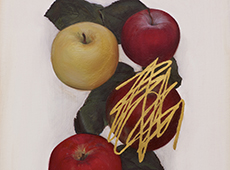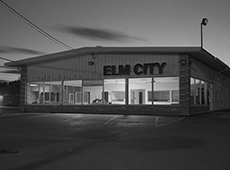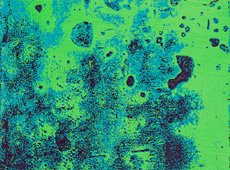The indexical relationship inherent in the medium, the relationship between the thing in the world photographed and the representation of that thing, opens endless questions about how we understand our relationship to our surroundings. The ability to express the very concept of paradox is one reason I love the photographic medium.
This is the second installment in a Tilted Arc ongoing feature, Women in the Landscape—conversations between women photographers whose work focuses on the land.
This conversation is with Jennifer Colten, an artist and educator working in St. Louis. Her work focuses on the ambiguous landscape—sites unnoticed, unexplained marks and the question of what makes ‘place’ important.
I am most interested in the dis-location of place and how that concept reflects our contemporary position in relationship to the environment. The “margins of the urban environment” are neither built for purpose and use, nor are they completely wild and untouched. These are places of residue and are often ignored or seen as problematic wasteland. These sites hover at the in-between, making the identification with these spaces uncertain.
These complex spaces exist both because of and in spite of our human presence. By this I mean we have built the infrastructure of the urban space, and we have marked the land and changed our environment in dramatic ways. But in spite of our interventions, nature, or the wildness of natural forces, persists. Humans have a responsibility to care for our environment and the destruction we have created. That is a daunting task. But, at the same time, I find it reassuring to see that Nature moves on—changed by human intervention for sure, but ultimately “uncaring” of our presence.
This is why many of my photographs depict nature overtaking the built environment. I am interested in shifting the focus from a human -centered view to one which contends with the environment as a sustaining and powerful force.
Through the continuing body of work Of Place and Non-Place, I play in both territories. I am making work that focuses on the sites of human residue—the lost wastelands of sorts, while simultaneously making work that shows ways that Nature overcomes.
I hope the growing body of work expresses the sometimes contradictory and sometimes symbiotic relationship that humans and the natural environment have in co-existence.
I am interested in shifting the focus from a human-centered view to one which contends with the environment as a sustaining and powerful force.
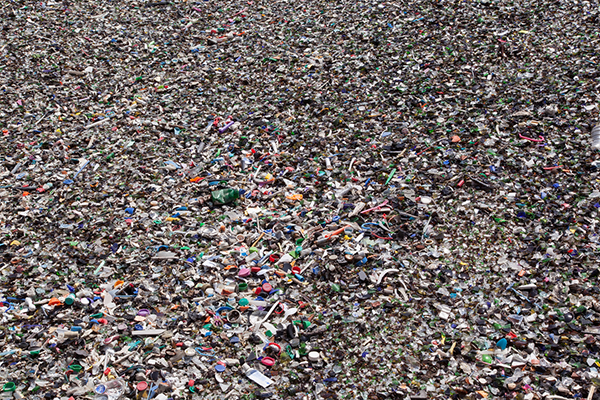
Jennifer Colten, “Encounter # 21: 63102.20130529.0006, 2013,” from the series, “Of Place and Non-Place.”
© Jennifer Colten. Courtesy of the artist.
This relates to my early questions regarding how, or if a place holds certain resonance. I wonder why some places make me stop and take notice especially when these places are often seemingly unremarkable or banal. In this way, the “encounter” is an unexpected event. I do not approach the place as confrontation, and unlike the early Exploration Photographers, I do not see the making of the photographs as somehow conquering the place. Instead I hope the photographs express the internal force and sustainability of Nature albeit alongside the obvious degradation that human intervention has created.
Actually, the whole title is Encounter # : Date. File number; for example:
Encounter #14: 63110.20130323.4976
I wanted to reference the idea of stumbling upon the site and maybe the surprise in the view whether that be banal or remarkable. I wanted this information to be presented as data, referencing possibly the police crime record or the geographical survey. I also wanted to reference time/date and then the file number pointing to the photographic process and specifically digital data. The idea of finding or encountering the residue becomes important because not only is this information that has been left behind, but it is then witnessed and documented through the act of making the photograph.
I hope the photographs express the internal force and sustainability of Nature albeit alongside the obvious degradation that human intervention has created.
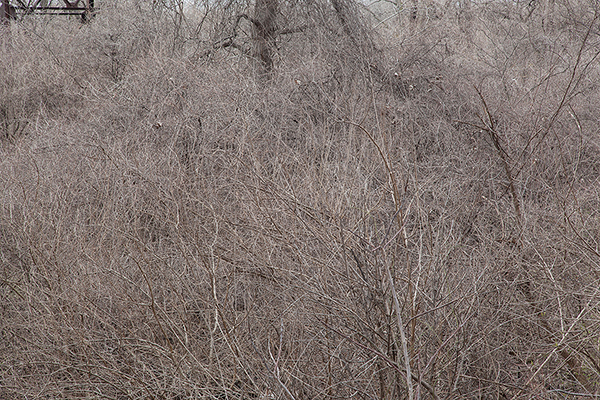
Jennifer Colten, “Encounter # 43: 62201.20130406.5220, 2013,” from the series, “Of Place and Non-Place”. © Jennifer Colten. Courtesy of the artist.
I am interested in some of the very same capabilities that photographic language can present. Like writing, photography has the capacity to describe with clear detail while also pointing to that which is beyond easy articulation or observation. I intentionally play on that very line you mention between “specificity and ambiguity” as a way to create uncertainty. I will often consciously eliminate horizon lines or create visual chaos within the controlled space of the frame as a way to deny the viewer access to context. At the same time, I tease the viewer, creating anticipation that what they see might give them access to verifiable truths. The bits of detail suggest one might know something about the place, but those bits become just information left behind, detached from their larger source or context.
Photography itself embodies paradox. The indexical relationship inherent in the medium, the relationship between the thing in the world photographed and the representation of that thing, opens endless questions about how we understand our relationship to our surroundings. The ability to express the very concept of paradox is one reason I love the photographic medium.
I do not feel tied to some kind of purist approach to my photography. After all, all photographs are sliced from a larger whole so the process of selection alone presents a very “untruthful” representation of reality. But that just gets us back to that beautiful idea of the paradox.
The indexical relationship inherent in the medium, the relationship between the thing in the world photographed and the representation of that thing, opens endless questions about how we understand our relationship to our surroundings. The ability to express the very concept of paradox is one reason I love the photographic medium.
Often towards the ending of one project I will begin to notice new aspects that seem aberrant yet continue to hold my attention. For instance when I was making the Surveillance work I would wander at night in all kinds of empty and extremely banal places. When people would ask me what I was doing I would respond that I was “making photographs of nothing.” I was serious about being interested in the idea of nothing. The idea of nothing led to my interest in the places of residue. One of the early photographs I felt held real meaning during that transition from Surveillance to Of Place and Non-Place was, Encounter #19: 63102.20100622.2318.
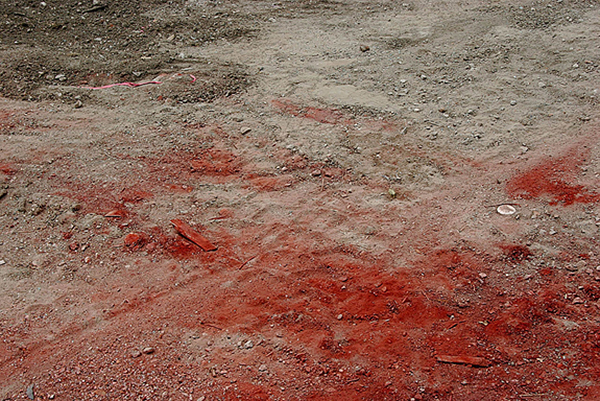
Jennifer Colten, “Encounter # 19: 63102.20100622.2318, 2010,” from the series, “Of Place and Non-Place.”
© Jennifer Colten. Courtesy of the artist.
The place where this image was made was very much like the kind of place where the Surveillance work was made. It was here that the idea of residue clearly began to evolve. It was also with this photograph that I began to think about the idea of the police report and all kinds of data recording of places. With the bright red that might be blood, I began to think about the crime scene. Police photographs that record traumatic events are often so banal and clinically dry. The presentation of an emotionally charged subject in a detached manner mirrors the duality in the photographic medium we were talking about earlier. The simultaneous record of fact (objective) coupled with the expression of (subjective) interpretation was finding visual voice.
The work I made in (Untitled) Landscapes finds its way over and over again in current work. In addition to being continually drawn to the dense and imbedded vegetation, questions regarding how to photograph the landscape in ways that extend historical and traditional ways of depicting the landscape still remain. The earlier (Untitled) Landscapes challenged conventions of the view. I denied the viewer’s eye a resting point and often eliminated a horizon line. I was interested in the expression of beauty residing alongside unrest. Many of the photographs had areas out of focus, and the last ones had large areas of darkness. I wanted to create a seductive desire to look and yet ultimately have the viewer’s expectations disrupted.
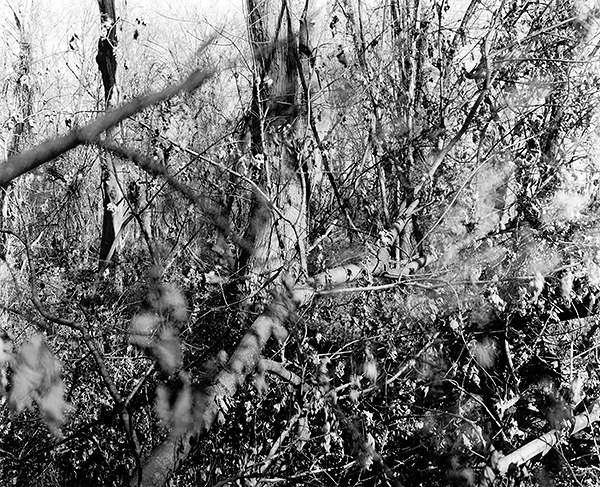
Jennifer Colten, “Untitled. 1997,” from the series, “Untitled (Landscapes).” © Jennifer Colten. Courtesy of the artist.
I denied the viewer’s eye a resting point and often eliminated a horizon line. I was interested in the expression of beauty residing alongside unrest.”
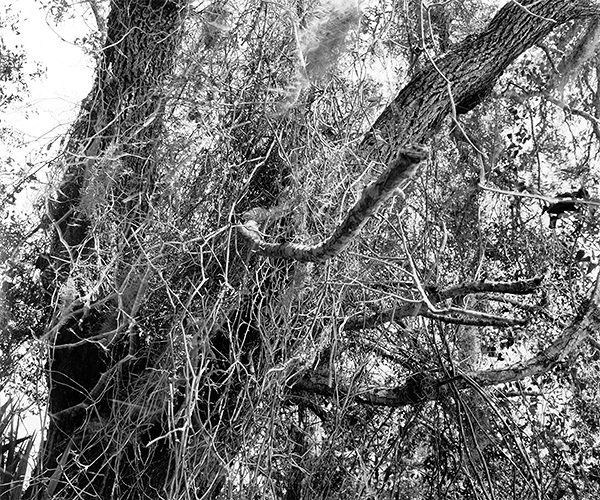
Jennifer Colten, “Untitled. 1996,” from the series, “Untitled (Landscapes).” © Jennifer Colten. Courtesy of the artist.
So even here you can see the ideas within this earlier landscape work found their way into the Surveillance work and parts of those ideas still remain in the current work.
lh Finally, what do you see as the ultimate outcome of the work? Is it online? In installation? In a book? Does it vary depending on project? Is the presentation of the photographs something you are thinking about while working?
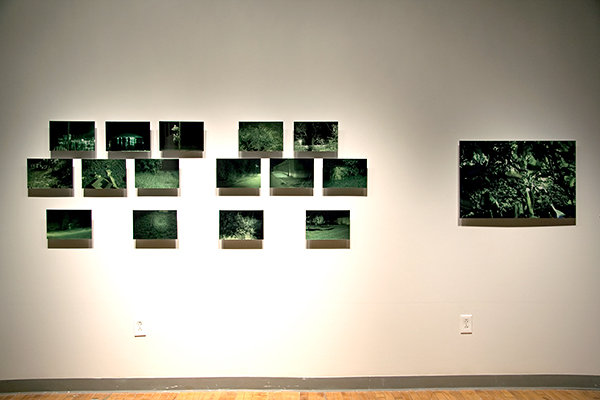
Jennifer Colten, Installation View, Des Lee Gallery, from the series, “Surveillance.” © Jennifer Colten.
Courtesy of the artist.
With the current work Of Place and Non-Place I am printing somewhat large- 24″ x 36″ and still deciding on final form the framing/mounting will take. I have presented the work framed, and also tried it floated against a white wall. I like the immediacy of the prints “floating” and I like the accessibility of the viewing experience. So, for that series I am still imagining possibilities. I have also dreamed of publishing some works in book form. I do think even though many of the ideas deal with experiencing space in one way or another, the opportunity to sequence for a book and design the work to be seen on a more intimate level would be exciting.
So this part of the process is integral to the ideas I am trying to express and I do think about the final execution from very early on in the making.
Jennifer Colten, lives, works and teaches in St. Louis. She received her MFA in photography from Massachusetts College of Art and a BA in English/American Studies from Wesleyan University in Connecticut. She currently teaches photography at the Sam Fox School of Visual Arts at Washington University in St. Louis.
Editor’s Notes:
To download a PDF of this interview, please click here.
To follow the Women in the Landscape series in its entirety, click here.
Subscribe to Tilted Arc
If you like this story, please consider subscribing. We are sticklers for privacy.
We will never sell or share your e-mail address.

